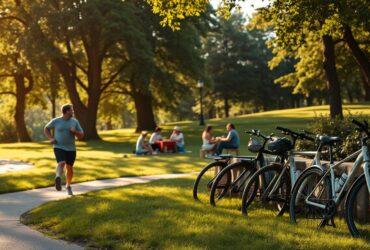High blood pressure, or hypertension, is often called a “silent killer” because it has no symptoms. It affects about half of American adults, many of whom don’t know they have it. For men over 40, controlling blood pressure is key to avoiding serious health issues like heart attacks and strokes.
This guide will share practical tips for managing hypertension. We’ll look at lifestyle changes, diet modifications, and the need for regular monitoring. You’ll learn about the DASH diet, exercise, stress management, and the role of medical support in keeping blood pressure healthy.
Understanding High Blood Pressure and Its Risks After 40
As men get older, knowing about high blood pressure is key. It’s a big problem, affecting over 78 million Americans. The danger grows with age.
How Blood Pressure Numbers Are Measured
Blood pressure has two numbers: systolic and diastolic. A reading of 120/80 mmHg is normal. Hypertension is 130/80 mmHg or higher. Stage 1 is 130-139 systolic or 80-89 diastolic. Stage 2 is 140/90 mmHg or above.
Common Risk Factors for Men Over 40
Many things raise the risk of high blood pressure in men over 40. These include:
- Getting older (90% risk by ages 55-65)
- Being overweight, especially around the belly (losing 7.7 lbs can cut risk by 50%)
- Not being active (exercise can lower BP by 8-10 points)
- Family history and race (Black adults are at higher risk)
- Chronic conditions like diabetes, kidney disease, and sleep apnea
Impact on Overall Health
High blood pressure can lead to serious problems. It raises the risk of heart disease, stroke, kidney damage, vision loss, and sexual issues. It’s vital to get regular blood pressure checks. This is because high blood pressure often has no symptoms.
Knowing the hypertension risks encourages men to act. They can keep their cardiovascular health in check through blood pressure measurement and lifestyle changes.
Essential Lifestyle Changes for Blood Pressure Control
Keeping blood pressure healthy needs big lifestyle changes. Men over 40 face a big health challenge. But, making a few key changes can really help.
Weight Management
Keeping a healthy weight is key for blood pressure. Losing just a few pounds can lower blood pressure by 5 to 10 mm Hg. Men should aim for a waist less than 40 inches to lower their risk of high blood pressure.
Regular Exercise
Doing regular aerobic exercise, like brisk walking or cycling, for 30 minutes a day can lower blood pressure by 5 to 8 mm Hg. This simple change can help avoid the need for blood pressure medicine.
Smoking Cessation
Quitting smoking is crucial for managing high blood pressure. Smoking increases the risk of heart disease and stroke. Quitting can greatly improve heart health.
Alcohol Moderation
Drinking no more than two drinks a day for men helps keep blood pressure healthy. Too much alcohol can harm the heart and raise blood pressure.
By making these lifestyle changes, men over 40 can control their blood pressure. Focusing on healthy lifestyle, weight management, and smoking cessation improves overall health and wellness.

| Lifestyle Factor | Impact on Blood Pressure |
|---|---|
| Maintaining a Healthy Weight | A small weight loss of 5-10 pounds can lower blood pressure by 5-10 mm Hg |
| Regular Aerobic Exercise | At least 30 minutes daily can lower blood pressure by 5-8 mm Hg |
| Quitting Smoking | Greatly reduces the risk of heart disease, heart attack, and stroke |
| Alcohol Moderation | Limiting to no more than 2 drinks per day for men can help maintain healthy blood pressure |
Diet Modifications to Lower Hypertension
For men over 40, managing high blood pressure through diet changes is key. The DASH (Dietary Approaches to Stop Hypertension) diet is a top choice for lowering blood pressure.
DASH Diet Fundamentals
The DASH diet focuses on eating more fruits, veggies, whole grains, low-fat dairy, and lean proteins. It suggests keeping sodium under 2,300 mg a day. For better blood pressure, aim for 1,500 mg a day.
Sodium Reduction Strategies
Lowering sodium intake is vital in the DASH diet. You can do this by reading labels, cooking at home, and using herbs and spices. Avoid high-sodium foods and choose low-sodium or no-salt-added options instead.
Heart-Healthy Food Choices
- Potassium-rich foods: Fruits and veggies like bananas, sweet potatoes, and leafy greens help balance sodium and support blood pressure.
- Fiber-rich choices: Whole grains, legumes, and nuts are full of fiber and nutrients that are good for your heart.
- Lean proteins: Choose lean meats, poultry, fish, and plant-based proteins like beans and lentils.
- Healthy fats: Add heart-healthy fats from olive oil, avocados, and nuts to your diet.
By changing your diet, men over 40 can manage their blood pressure better. This can also lower the risk of other health problems.
Exercise and Physical Activity Guidelines
Regular physical activity is key to controlling blood pressure and keeping your heart healthy. The latest guidelines say adults over 40 should do at least 150 minutes of moderate-intensity aerobic exercise. Or, they should aim for 75 minutes of vigorous-intensity aerobic exercise each week.
Aerobic activities like brisk walking, jogging, cycling, swimming, or dancing can lower blood pressure by 5-7 mmHg. This can cut the risk of heart disease by 20-30%.
It’s also important to do strength training exercises at least twice a week. These exercises can lower blood pressure just like aerobic activities. They are a great addition to your fitness routine.
Try to mix aerobic and strength training exercises throughout the week. Being consistent is crucial. Regular activity helps keep blood pressure in check and lowers the risk of heart problems.
Before starting a new exercise program, always talk to a healthcare professional. Especially if you have health issues. Proper aerobic exercise, strength training, and staying active can help manage and prevent high blood pressure.
| Recommendation | Duration |
|---|---|
| Moderate-intensity aerobic exercise | At least 150 minutes per week |
| Vigorous-intensity aerobic exercise | At least 75 minutes per week |
| Strength training exercises | At least 2 days per week |
Stress Management and Sleep Optimization
Chronic stress can harm your blood pressure and health. But, there are ways to manage stress and improve sleep. These are key for a healthy heart.
Effective Relaxation Techniques
Adding relaxation practices to your day can ease stress. Here are some good ones:
- Meditation: Spend 10-15 minutes each day focusing on your breath and clearing your mind.
- Deep breathing exercises: Take slow, deep breaths to activate the parasympathetic nervous system and induce a state of calm.
- Yoga: Gentle yoga poses and stretches can reduce muscle tension and promote relaxation.
- Progressive muscle relaxation: Systematically tense and release different muscle groups to release physical stress.
Importance of Quality Sleep
Try to sleep 7-9 hours each night. A calm sleep space, regular sleep times, and avoiding big meals or caffeine before bed are key. Good sleep helps control blood pressure and stress.
Work-Life Balance Tips
Having a good work-life balance is crucial. Set work and personal time limits, focus on important tasks, and enjoy hobbies. Exercise and social connections also boost your health.
By using these stress and sleep tips, you can help your heart health and life quality.
Home Monitoring and Medical Support
Tracking your blood pressure at home is key to seeing how well your treatment is working. Start by using a good home blood pressure monitor. Keep a log of your readings. Share this with your healthcare professional at your check-ups. This helps them tailor your treatment to fit your needs.
Your doctor might suggest lifestyle changes and medication management to manage your blood pressure. If you’re on medication, take it as directed and tell your doctor about any side effects. Regular visits to the doctor are vital for managing your blood pressure and staying healthy.
The Benefits of Home Monitoring
- Home blood pressure monitoring is more sensitive (90% vs. 81%) and specific (84% vs. 76%) than in-office measurements for diagnosing hypertension.
- Combining home monitoring with remote or telephone physician monitoring is recommended by the Centers for Disease Control and Prevention.
- Use a validated, fully automated upper arm blood pressure device and record readings for 3-7 days, taking two measurements separated by at least one minute, twice per day.
Collaborating with Your Healthcare Team
Work closely with your doctor to create a good blood pressure monitoring and treatment plan. Share your home readings and talk about any changes or side effects from your medication. Your healthcare team can help you keep your blood pressure in check through teamwork.

Managing high blood pressure is a long-term effort, and regular medical support is crucial. By monitoring your blood pressure at home, making lifestyle changes, and following your medication plan with your healthcare team’s guidance, you can control your blood pressure and enhance your health.
Conclusion
Controlling blood pressure for men over 40 needs a full plan. This includes lifestyle changes, diet, exercise, stress management, and medical help. By doing these things, you can lower your risk of heart disease and stroke.
Adopting heart-healthy habits is key. This means eating right, cutting down on salt, staying active, and managing stress. Also, keep an eye on your blood pressure and work with your doctor to keep it healthy.
By making these lifestyle changes, you can live a healthier life. With the right attitude and effort, you can manage your blood pressure and avoid serious heart problems. Start this journey to better heart health and enjoy a better life.










